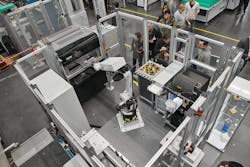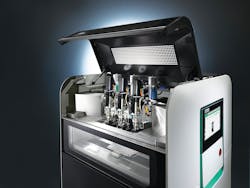Networked cell features Arburg printer
At the March event, the printer made custom vacuum grippers that each fit on one of six different chess pieces that had been previously made on a 3-D printer.
In the demonstration, visitors could select from a touch screen a square base designed to fit the bottom of a particular piece. The robot’s job was to handle, using a bar code, the visitors’ requests, from the selection of the base to its final placement.
The process required the robot to undergo several end-of-arm tooling changes.
The demonstration of additive manufacturing in an automated production cell was not intended for large-scale part production. However, it did show that single-unit parts can be produced on demand in a fully automated Freeformer 300-3X, which can be networked with a robot to do work that normally requires human intervention.
Separately, a second Freeformer 300-3X produced movable gripper fingers made from three different materials. The printer used ABS, TPE and a support material to make the part, which did not require any additional assembly. The printer can work with many materials, including ABS, polyamide 10, PC, PP and specialty resins.
At the Rapid + TCT 2019 trade show May 21-23 in Detroit, Arburg will officially introduce the machine to North America. There, the company will debut a new closed-cooling system option that uses an industrial cooling water connection. The system allows the machine to process materials at temperatures of up to 392 degrees Fahrenheit. Previously, build chamber temperatures could not exceed 248 degrees and cooling was achieved only by fans.
The printer will be used during the show to produce resilient gripper fingers in hard and soft combinations made of ABS, TPE and a support material. It can build parts from multiple materials because it features three discharge units, which allows three different resins — or two resins and a support material — to be used during the printing process without any additional machine adjustments. Arburg said it is the first 3-D printer offering this feature.
The company said the printer’s ability to use the same type of resin pellets used in injection molding machines sets it apart from other 3-D printers. It does not require special cartridges or printer packs.
The machine has been well-received in the automotive and medical industries due to its ability to process a wide range of TPEs, the company said. During a single job, it can print a part with two types of thermoplastics, two types of elastomers, or one type of thermoplastic and one type of elastomer.
Bruce Adams, senior staff reporter
Contact:
Arburg Inc. Rocky Hill, Conn., 860-667-6500,


